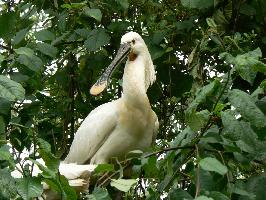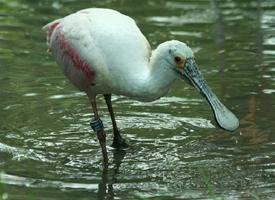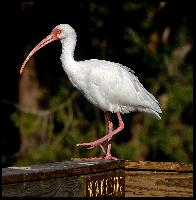
Poids et mesures
| Longueur | de 80 à 93 cm |
|---|---|
| Poids | de 0,8 à 2 kg |
| Envergure des ailes | de 120 à 135 cm |
Description de l'animal
The Eurasian spoonbill, scientifically known as Platalea leucorodia, is a captivating species of wading bird that belongs to the Threskiornithidae family, which also includes ibises. This unique bird is easily identifiable by its distinct features and behaviors, making it a subject of interest among birdwatchers and wildlife enthusiasts.One of the most striking characteristics of the Eurasian spoonbill is its spoon-shaped bill, from which it derives its common name. The bill is long, flattened, and broad at the tip, resembling a spatula or spoon. This specialized bill is not just for show; it plays a crucial role in the bird's feeding technique. The spoonbill sweeps its bill from side to side in shallow waters to catch its prey, which includes a variety of aquatic animals such as small fish, crustaceans, aquatic insects, worms, and amphibians.
Adult Eurasian spoonbills boast a predominantly white plumage, which adds to their elegant appearance. During the breeding season, adults develop a more ornate look with nuptial plumes on the back of the head, chest, and back. They may also display a yellowish breast patch and a crest of elongated feathers. The legs are long and black, supporting the bird's tall stature, while the eyes are surrounded by a bare patch of skin that can appear greenish or yellowish.
Juvenile spoonbills differ from adults by having a paler bill and lacking the ornamental plumes and yellow breast patch. Their plumage may also show a slight greyish or brownish tint compared to the pure white of the adults.
Eurasian spoonbills inhabit a variety of wetland habitats across their range, which spans from Western Europe and North Africa to the Far East, including parts of China and Japan. They prefer shallow, freshwater or brackish wetlands, estuaries, and marshes, where they can be found foraging for food. These birds are social creatures, often seen in flocks, and are known to breed in colonies, sometimes alongside other species of herons, egrets, and ibises.
The breeding season sees these birds constructing large, bulky nests in trees, reeds, or on islands, using twigs and vegetation. The female typically lays between three to five eggs, which both parents then incubate. Once hatched, the chicks are fed by both parents until they are ready to fledge and forage for food on their own.
Migration patterns of the Eurasian spoonbill vary among populations. Birds from the northern parts of their range tend to migrate southwards during the winter, seeking warmer climates, while those in the southern and warmer parts of their range are often resident or make shorter migratory movements.
Despite facing threats such as habitat loss, pollution, and disturbance from human activities, the Eurasian spoonbill has maintained a stable population in many parts of its range, thanks in part to conservation efforts and protected areas. The species is currently listed as Least Concern by the International Union for Conservation of Nature (IUCN), reflecting its relatively wide distribution and stable population numbers. However, continued conservation efforts are essential to ensure the survival of this unique and fascinating bird for future generations to enjoy.
Animaux similaires
Nouvelles photos d'animaux
Top 10 des animaux
- Dolphin gull (Leucophaeus scoresbii)
- Diana monkey (Cercopithecus diana)
- Moustached guenon (Cercopithecus cephus)
- Galápagos tortoise (Geochelone nigra complex)
- Japanese macaque (Macaca fuscata)
- Russian tortoise (Testudo horsfieldii)
- Stone loach (Barbatula barbatula)
- Greek tortoise (Testudo graeca)
- Common flying dragon (Draco volans)
- Vendace (Coregonus albula)


